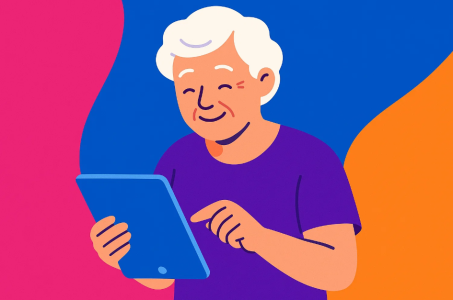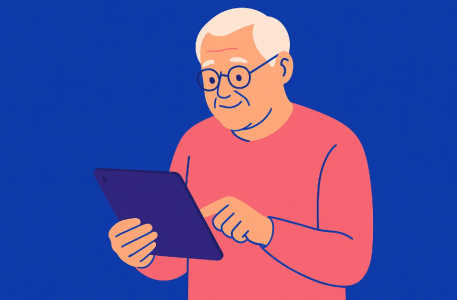Grandma’s got a gadget: Seniors embrace smart tech for everyday life
An iPhone in one hand and an Echo Dot on the counter – it’s not the setup you’d expect at your grandma’s house a decade ago. But times have changed. Meet Sue Godfrey, a grandmother who has discovered that a few smart gadgets can make daily life much easier.
In a recent piece, Sue shared how her smartphone and a little voice assistant speaker help her look up cooking recipes and set reminders, showing that seniors are more tech-savvy than many people think. From banking online to getting recipe tips from Alexa, older Australians are embracing technology in surprising ways – and having a bit of fun along the journey.
Sue’s not alone. Whether it’s asking “Hey Siri, what’s the weather?” or telling Alexa to remind you to take your 10am medication, seniors across Australia are tapping into smart technology for everyday tasks.
Online banking is one area where many have made the leap. Why queue at a branch or fuss with paper passbooks if an app can do the job? In fact, a 2025 survey by financial comparison site Savvy found 70% of Australians use online banking monthly, and older adults were among the keenest. Surprisingly, the 55–64 age group had the highest online banking usage (83%), beating out even the youngest 18–24 year-olds. It seems grandparents might love internet banking even more than their grandkids do! Meanwhile, for those over 65, banking apps on smartphones are a bit less common – only about 35% of over-65s use mobile banking apps each months – but many prefer the larger screens of computers or tablets for managing finances.
The key takeaway? Older Australians are definitely getting on board with digital banking, especially when it makes life simpler.
It’s not just banking. Personal assistants like Amazon’s Alexa (on Echo Dot speakers) or Apple’s Siri can handle a range of helpful chores. Need to remember an appointment or when to take your pills? Just ask Alexa to jot it down and ping you at the right time.
“Medication errors account for thousands of injuries each year,” notes one guide for seniors, so setting up voice reminders can be a literal life-saver. You can even have these devices call your family or doctor if you need help, or give you recipe step-by-steps while you cook. Many of Alexa’s best features – from playing your favourite 1960s rock music to telling you bad jokes – are entirely free to use, no subscription needed. It’s like having a friendly helper on standby 24/7.
As one tech reviewer put it, Alexa’s functions “have a wide range of uses for older adults,” and most don’t cost a cent. For seniors living solo, these gadgets can also add a sense of security: you can control lights or the thermostat with your voice, and even ask for an “urgent response” in emergencies if you’ve set that up. It’s a brave new world of convenience – one that some seniors are finding delightful once they dip a toe in.
Of course, not every older Aussie finds it easy to jump into the digital fast lane. Many grew up in an era of rotary phones and handwritten letters – a far cry from smartphones and Wi-Fi. The learning curve can be steep and frustrating.
Just ask 89-year-old Edna Cable, who described how using a tablet for the first time “just swings around and does funny things… It’s too stressful. The other night, I tried so much that I ended up in tears.” Her experience, featured on ABC News, is a poignant reminder that new tech can feel overwhelming. Tech trainers who work with seniors say older people are being “dragged along into this new world whether they like it or not” as more essential services go digital. It’s sink or swim, and not everyone is given a lifejacket.
The good news is that help is at hand – and eager learners abound. Across the country, community centers and libraries are hosting “Tech Savvy Seniors” seminars that often book out weeks in advance with dozens of attendees.
Source: 9 News Australia / YouTube
In Perth, for example, over 200 seniors packed a training session in 2018, armed with tablets and smartphones (and perhaps a grandchild’s hand-me-down notebook for taking notes). These workshops, some funded by government programs and Telstra, give older adults a chance to conquer their tech fears with patient guidance.
“What I’ve learnt so far is to try and stay calm,” one 75-year-old gentleman chuckled after a class, acknowledging the nerves that come with the territory. Governments are also recognising the importance of digital inclusion. Back in 2018, the federal government committed $47 million to a “Be Connected” initiative dedicated to improving seniors’ digital skills. At that time nearly 49% of over-65s were not online at all, so the program aimed to bridge that divide with free lessons and resources.
And it’s making a difference – a recent official report highlighted a “significant shift” in older people’s online habits, noting that Australians over 75 increased their internet use from about half in 2019 to 94% by 2022. In other words, necessity and support have turned the tide, bringing a huge number of seniors into the digital world in just a few years.
Even as more older Australians log on, we can’t ignore those who still feel left behind. Access and attitude vary widely in the senior community. Some have multiple devices and love using Facebook, WhatsApp, or online banking daily. Others avoid the internet due to lack of interest, fear of making a mistake, or concerns about security.
And there are legitimate worries: scams targeting seniors are on the rise, and many older people are cautious about privacy. A recent survey noted that 80% of Australians over 65 worry about the security of their personal information online, and nearly 1 in 5 had already fallen victim to a scam. That’s a sobering statistic that gives pause. It’s one thing to teach Grandma how to text – it’s another to ensure she’s not going to click on a fake bank email and lose her savings.
Digital literacy isn’t just about how to use the tech, but also how to use it safely. This is where family support and community education are crucial. Often, a patient child or grandchild can help set up a tablet with the right security and show which messages to ignore. And organisations like the eSafety Commissioner and Council on the Ageing (COTA) have guides specifically for seniors on avoiding online fraud and staying safe while connected.
Policymakers and banks are also being urged to remember that “not everyone is online, and not everyone wants to be.” Patricia Sparrow, Chief Executive of COTA Australia, has warned that the headlong rush into cashless, app-only services could “cut off access to vital banking services for many older Australians”, especially the most vulnerable.
“With advancements in technology it’s only natural to see a shift to digital… that’s not a problem for many older Australians,” Sparrow says, “but we can’t let that shift come at the expense of those in the community who still rely heavily on in-person services.” This balanced view is important.
Yes, a great number of seniors are happy to tap and swipe for their finances — some even prefer online banking to waiting in line — yet others still depend on the human touch, like the friendly bank teller who knows their name. As Sparrow noted, “many older Australians are very happy to use new banking technology… but we can’t ignore the fact that physical banking is still important to many people.” The goal, she and other advocates suggest, is to make tech inclusive: design apps and websites that are senior-friendly (big text, clear instructions), provide alternatives for those who can’t use them, and offer plenty of support so no one has to feel embarrassed if they need a hand.
Ultimately, the rise of smartphones and smart speakers among seniors is a story of empowerment. It’s about staying independent and connected. How heartwarming is it when a great-grandma can video call her family interstate on FaceTime? Or when a retiree in a rural town uses a telehealth app to consult a city specialist without the five-hour drive?
These things were pipe dreams not long ago. Now they’re increasingly part of normal life for older people. During the pandemic lockdowns, technology became a lifeline – video chats, online shopping, and tele-health kept many seniors safe at home yet still “in the loop” with society. That period also proved that once the initial hurdles are cleared, older adults can and do adapt.
In fact, they may have closed the digital gap faster than anyone expected. The Australian Communications and Media Authority reported that the use of internet-connected smart devices among seniors 75+ quadrupled between 2018 and 2022a. It seems once Grandma discovers the joys of Netflix binges or Alexa’s ability to play her favourite ABBA songs, there’s no going back!
Source: Sky News Australia / YouTube
Perhaps the most important change is in mindset. Seniors are increasingly expecting technology to cater to them, not the other way around. As one National Seniors advocate bluntly put it, if governments and businesses push everything to digital and make old methods harder, “let’s call it straight – it’s age discrimination.” His point: older people deserve user-friendly design and the ability to talk to a real person when needed. We all age, after all, and none of us want to be left out or disempowered by the tools of daily life. The ideal scenario is tech that augments senior living – making it safer, richer and more convenient – without erasing the personal, human elements that older generations value.
On the lighter side, embracing tech can bring a lot of joy and novelty into seniors’ lives. It’s not uncommon now to see a group of grey nomads on a caravan trip using Google Maps and podcasts on their iPads, or a grandparent gleefully asking Alexa to tell a joke (and then rolling their eyes at how corny it is).
One Sydney retiree in her 80s recently became a minor TikTok star with cooking videos, defying every stereotype about what seniors can or can’t do. Stories like hers – and Sue Godfrey’s experience with her iPhone and Echo Dot – show that age is no barrier to learning new tricks. In fact, having more free time in retirement can be the perfect opportunity to play with new gadgets. As long as there’s patience (and perhaps a handy cheat-sheet of instructions), many older folks find they can master that smartphone or smart speaker. And if all else fails, there’s always the classic move: “Call the grandson to fix it!” (Tech support might just be the new role of grandchildren everywhere.)
So here’s to the growing tribe of connected seniors – those who swap knitting patterns on Facebook, use online banking without fear, and aren’t afraid to say “Hey Google, play Waltzing Matilda.” They remind us that technology isn’t just the province of the young. It can be a friend and ally in our golden years, helping us live more easily and stay connected to what matters.
And if you’re an older Aussie who hasn’t yet taken the tech plunge, don’t worry – you’re in good company, and it’s never too late to learn. With a bit of support and curiosity, you might just find these gizmos aren’t so intimidating after all – they might even make life a whole lot easier.

So, what do you think – are you ready to teach an old dog new tech tricks and maybe ask Alexa to set a reminder, or do you prefer to keep life strictly old-school?
READ MORE: Buckle up, seniors! New driving regulations could target elderly licence holders
In a recent piece, Sue shared how her smartphone and a little voice assistant speaker help her look up cooking recipes and set reminders, showing that seniors are more tech-savvy than many people think. From banking online to getting recipe tips from Alexa, older Australians are embracing technology in surprising ways – and having a bit of fun along the journey.
Banking, Reminders, and Beyond – There’s a Smart Trick for That
Sue’s not alone. Whether it’s asking “Hey Siri, what’s the weather?” or telling Alexa to remind you to take your 10am medication, seniors across Australia are tapping into smart technology for everyday tasks.
Online banking is one area where many have made the leap. Why queue at a branch or fuss with paper passbooks if an app can do the job? In fact, a 2025 survey by financial comparison site Savvy found 70% of Australians use online banking monthly, and older adults were among the keenest. Surprisingly, the 55–64 age group had the highest online banking usage (83%), beating out even the youngest 18–24 year-olds. It seems grandparents might love internet banking even more than their grandkids do! Meanwhile, for those over 65, banking apps on smartphones are a bit less common – only about 35% of over-65s use mobile banking apps each months – but many prefer the larger screens of computers or tablets for managing finances.
The key takeaway? Older Australians are definitely getting on board with digital banking, especially when it makes life simpler.
It’s not just banking. Personal assistants like Amazon’s Alexa (on Echo Dot speakers) or Apple’s Siri can handle a range of helpful chores. Need to remember an appointment or when to take your pills? Just ask Alexa to jot it down and ping you at the right time.
“Medication errors account for thousands of injuries each year,” notes one guide for seniors, so setting up voice reminders can be a literal life-saver. You can even have these devices call your family or doctor if you need help, or give you recipe step-by-steps while you cook. Many of Alexa’s best features – from playing your favourite 1960s rock music to telling you bad jokes – are entirely free to use, no subscription needed. It’s like having a friendly helper on standby 24/7.
As one tech reviewer put it, Alexa’s functions “have a wide range of uses for older adults,” and most don’t cost a cent. For seniors living solo, these gadgets can also add a sense of security: you can control lights or the thermostat with your voice, and even ask for an “urgent response” in emergencies if you’ve set that up. It’s a brave new world of convenience – one that some seniors are finding delightful once they dip a toe in.
From Tech-Shy to Tech-Savvy – Learning Curve or Cliff?
Of course, not every older Aussie finds it easy to jump into the digital fast lane. Many grew up in an era of rotary phones and handwritten letters – a far cry from smartphones and Wi-Fi. The learning curve can be steep and frustrating.
Just ask 89-year-old Edna Cable, who described how using a tablet for the first time “just swings around and does funny things… It’s too stressful. The other night, I tried so much that I ended up in tears.” Her experience, featured on ABC News, is a poignant reminder that new tech can feel overwhelming. Tech trainers who work with seniors say older people are being “dragged along into this new world whether they like it or not” as more essential services go digital. It’s sink or swim, and not everyone is given a lifejacket.
The good news is that help is at hand – and eager learners abound. Across the country, community centers and libraries are hosting “Tech Savvy Seniors” seminars that often book out weeks in advance with dozens of attendees.
Source: 9 News Australia / YouTube
In Perth, for example, over 200 seniors packed a training session in 2018, armed with tablets and smartphones (and perhaps a grandchild’s hand-me-down notebook for taking notes). These workshops, some funded by government programs and Telstra, give older adults a chance to conquer their tech fears with patient guidance.
“What I’ve learnt so far is to try and stay calm,” one 75-year-old gentleman chuckled after a class, acknowledging the nerves that come with the territory. Governments are also recognising the importance of digital inclusion. Back in 2018, the federal government committed $47 million to a “Be Connected” initiative dedicated to improving seniors’ digital skills. At that time nearly 49% of over-65s were not online at all, so the program aimed to bridge that divide with free lessons and resources.
And it’s making a difference – a recent official report highlighted a “significant shift” in older people’s online habits, noting that Australians over 75 increased their internet use from about half in 2019 to 94% by 2022. In other words, necessity and support have turned the tide, bringing a huge number of seniors into the digital world in just a few years.
The Digital Divide: Not All Grey Nomads Have Google
Even as more older Australians log on, we can’t ignore those who still feel left behind. Access and attitude vary widely in the senior community. Some have multiple devices and love using Facebook, WhatsApp, or online banking daily. Others avoid the internet due to lack of interest, fear of making a mistake, or concerns about security.
And there are legitimate worries: scams targeting seniors are on the rise, and many older people are cautious about privacy. A recent survey noted that 80% of Australians over 65 worry about the security of their personal information online, and nearly 1 in 5 had already fallen victim to a scam. That’s a sobering statistic that gives pause. It’s one thing to teach Grandma how to text – it’s another to ensure she’s not going to click on a fake bank email and lose her savings.
Digital literacy isn’t just about how to use the tech, but also how to use it safely. This is where family support and community education are crucial. Often, a patient child or grandchild can help set up a tablet with the right security and show which messages to ignore. And organisations like the eSafety Commissioner and Council on the Ageing (COTA) have guides specifically for seniors on avoiding online fraud and staying safe while connected.
Policymakers and banks are also being urged to remember that “not everyone is online, and not everyone wants to be.” Patricia Sparrow, Chief Executive of COTA Australia, has warned that the headlong rush into cashless, app-only services could “cut off access to vital banking services for many older Australians”, especially the most vulnerable.
“With advancements in technology it’s only natural to see a shift to digital… that’s not a problem for many older Australians,” Sparrow says, “but we can’t let that shift come at the expense of those in the community who still rely heavily on in-person services.” This balanced view is important.
Yes, a great number of seniors are happy to tap and swipe for their finances — some even prefer online banking to waiting in line — yet others still depend on the human touch, like the friendly bank teller who knows their name. As Sparrow noted, “many older Australians are very happy to use new banking technology… but we can’t ignore the fact that physical banking is still important to many people.” The goal, she and other advocates suggest, is to make tech inclusive: design apps and websites that are senior-friendly (big text, clear instructions), provide alternatives for those who can’t use them, and offer plenty of support so no one has to feel embarrassed if they need a hand.
Embracing the Upside of Tech in Our Golden Years
Ultimately, the rise of smartphones and smart speakers among seniors is a story of empowerment. It’s about staying independent and connected. How heartwarming is it when a great-grandma can video call her family interstate on FaceTime? Or when a retiree in a rural town uses a telehealth app to consult a city specialist without the five-hour drive?
These things were pipe dreams not long ago. Now they’re increasingly part of normal life for older people. During the pandemic lockdowns, technology became a lifeline – video chats, online shopping, and tele-health kept many seniors safe at home yet still “in the loop” with society. That period also proved that once the initial hurdles are cleared, older adults can and do adapt.
In fact, they may have closed the digital gap faster than anyone expected. The Australian Communications and Media Authority reported that the use of internet-connected smart devices among seniors 75+ quadrupled between 2018 and 2022a. It seems once Grandma discovers the joys of Netflix binges or Alexa’s ability to play her favourite ABBA songs, there’s no going back!
Source: Sky News Australia / YouTube
Perhaps the most important change is in mindset. Seniors are increasingly expecting technology to cater to them, not the other way around. As one National Seniors advocate bluntly put it, if governments and businesses push everything to digital and make old methods harder, “let’s call it straight – it’s age discrimination.” His point: older people deserve user-friendly design and the ability to talk to a real person when needed. We all age, after all, and none of us want to be left out or disempowered by the tools of daily life. The ideal scenario is tech that augments senior living – making it safer, richer and more convenient – without erasing the personal, human elements that older generations value.
On the lighter side, embracing tech can bring a lot of joy and novelty into seniors’ lives. It’s not uncommon now to see a group of grey nomads on a caravan trip using Google Maps and podcasts on their iPads, or a grandparent gleefully asking Alexa to tell a joke (and then rolling their eyes at how corny it is).
One Sydney retiree in her 80s recently became a minor TikTok star with cooking videos, defying every stereotype about what seniors can or can’t do. Stories like hers – and Sue Godfrey’s experience with her iPhone and Echo Dot – show that age is no barrier to learning new tricks. In fact, having more free time in retirement can be the perfect opportunity to play with new gadgets. As long as there’s patience (and perhaps a handy cheat-sheet of instructions), many older folks find they can master that smartphone or smart speaker. And if all else fails, there’s always the classic move: “Call the grandson to fix it!” (Tech support might just be the new role of grandchildren everywhere.)
So here’s to the growing tribe of connected seniors – those who swap knitting patterns on Facebook, use online banking without fear, and aren’t afraid to say “Hey Google, play Waltzing Matilda.” They remind us that technology isn’t just the province of the young. It can be a friend and ally in our golden years, helping us live more easily and stay connected to what matters.
And if you’re an older Aussie who hasn’t yet taken the tech plunge, don’t worry – you’re in good company, and it’s never too late to learn. With a bit of support and curiosity, you might just find these gizmos aren’t so intimidating after all – they might even make life a whole lot easier.
Key Takeaways
- Smart tech making life easier: Australian seniors are increasingly using smartphones, voice assistants, and other gadgets to handle daily tasks – from online banking to medication reminders – exemplified by grandma Sue’s success with her iPhone and Echo Dot.
- Tech adoption is surging: Older Australians have rapidly embraced digital life in recent years. Internet use among over-75s jumped from about 50% in 2019 to over 90% by 2022, and many attend “Tech Savvy Seniors” classes to learn new skills.
- Benefits of staying connected: Embracing technology can help seniors maintain independence and stay connected – think easy bill payments, video calls with family, access to telehealth and entertainment at the voice command of “Hey Alexa…”. Smart speakers and apps offer convenience and even added safety (like emergency calls or reminders).
- Bridging the divide with support: Not all seniors find tech easy – some struggle with digital changes or worry about scams. Advocates urge that services remain inclusive (keep alternatives like bank branches) and that more training and support be provided. With patience and the right help, even the tech-shy can gain confidence and enjoy the perks of the digital age.
So, what do you think – are you ready to teach an old dog new tech tricks and maybe ask Alexa to set a reminder, or do you prefer to keep life strictly old-school?
READ MORE: Buckle up, seniors! New driving regulations could target elderly licence holders
Last edited:









